Table A. Comparative Summary Statistics for Real Estate
Activities Sector: Philippines, 2019 and 2020

Majority of the establishments were in real estate activities with own or leased property industry
The preliminary results of the Annual Survey of Philippine Business and Industry (ASPBI) showed that a total of
Between the two industry groups, real estate activities with own or leased property posted a higher number of establishments of 4,519 or 88.2 percent of the total. Real estate activities on a fee or contract basis, on the other hand, recorded 602 establishments (11.8%). (Table 1 and Figure 1)
Figure 1. Percentage Distribution of Establishments for Real Estate Activities Sector
by Industry Group: Philippines, 2020
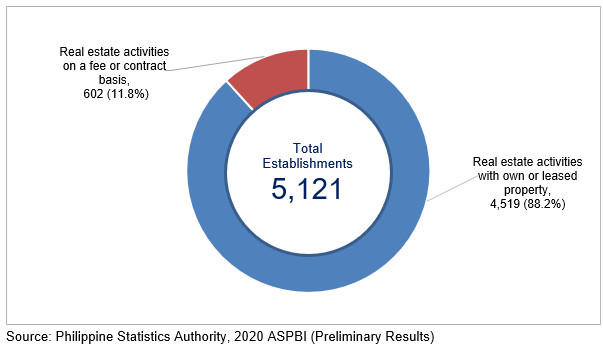
At the regional level, the National Capital Region (NCR) had the most number of establishments of 3,040 or
Real estate activities with own or leased property industry employed majority of the workers
In 2020, the total employment for the sector was recorded at 97,237 workers, a decrease of -8.2 percent from the 105,973 workers reported in 2019. Of the total employment, majority of the workers were paid employees numbering to 92,079 (94.7%), while the rest were working owners and unpaid workers. (Tables A and 1)
By industry group, real estate activities with own or leased property employed 88,184 workers or 90.7 percent of the total. The remaining 9,053 workers (9.3%) were engaged in real estate activities on a fee or contract basis. (Table 1 and Figure 2)
Figure 2. Distribution of Employment for Real Estate Activities Sector
by Industry Group: Philippines, 2020
.
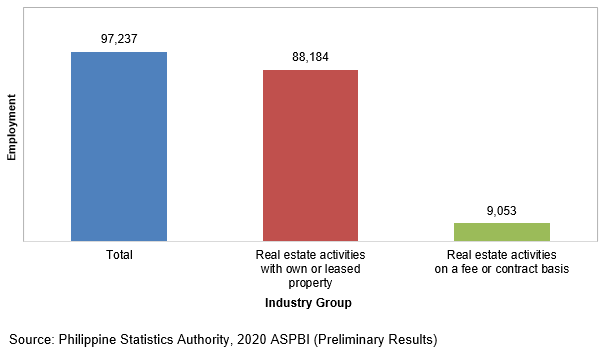
By region, NCR hired the highest number of workers of 68,742 (70.7%). This was followed by Central Visayas with 7,053 workers (7.3%) and CALABARZON with 6,435 workers (6.6%). (Table 3)
In 2020, the sector’s average number of workers per establishment was recorded at 19, a decrease of -5.0 percent from the 20 workers per establishment reported in 2019. (Tables A and 2)
Real estate activities with own or leased property with 20 workers per establishment slightly surpassed the sector’s average of 19 workers per establishment. On the other hand, real estate activities on a fee or contract basis recorded an average of 15 workers per establishment. (Table 2)
Real estate activities with own or leased property industry paid the highest average annual compensation
In 2020, the total compensation paid by the sector to its employees amounted to PhP 41.78 billion. This figure was lower by -0.4 percent than the recorded compensation of 41.93 billion in 2019. (Tables A and 1)
Of the total compensation paid by the sector, PhP 39.69 billion (95.0%) was paid to employees working in real estate activities with own or leased property. The remaining portion of the total compensation worth PhP 2.10 billion (5.0%) was paid to employees of real estate activities on a fee or contract basis. (Table 1)
The sector paid an average annual compensation of PhP 453.75 thousand per paid employee in 2020. This was higher by 13.9 percent from the previous year’s average annual compensation of PhP 398.48 thousand per paid employee. Employees of real estate activities with own or leased property received an average annual pay of
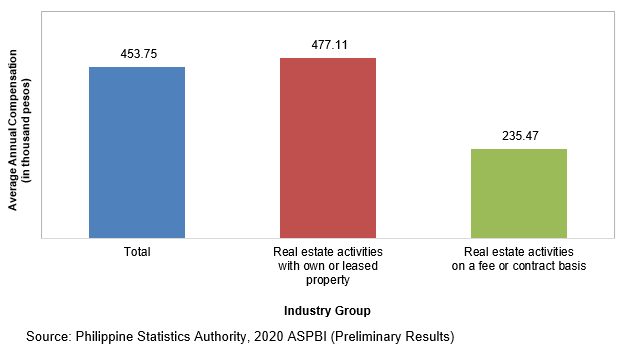
Among the regions, NCR paid the highest average annual compensation of PhP 545.79 thousand per paid employee. Central Visayas and Ilocos Region ranked second and third, paying an average annual compensation of
Real estate activities with own or leased property industry contributed the major share to total revenue and expense
The total revenue generated by the sector reached PhP 646.84 billion in 2020, a decrease of -41.3 percent from the PhP 1.10 trillion in 2019. (Tables A and 1, Figure 4)
Real estate activities with own or leased property contributed the major share to the total revenue of the sector, amounting to PhP 632.91 billion (97.8%). On the other hand, real estate activities on a fee or contract basis generated a revenue of PhP 13.93 billion (2.2%). (Table 1 and Figure 4)
Meanwhile, the total expense incurred by the sector amounted to PhP 472.90 billion in 2020, a decrease of
Of the total revenue generated by the real estate activities industry, NCR earned PhP 568.64 billion (87.9%), the highest among other regions. Similarly, NCR incurred the highest expense of PhP 406.45 billion or 85.9 percent of the total. (Table 3)
Figure 4. Revenue and Expense for Real Estate Activities Sector
by Industry Group: Philippines, 2020
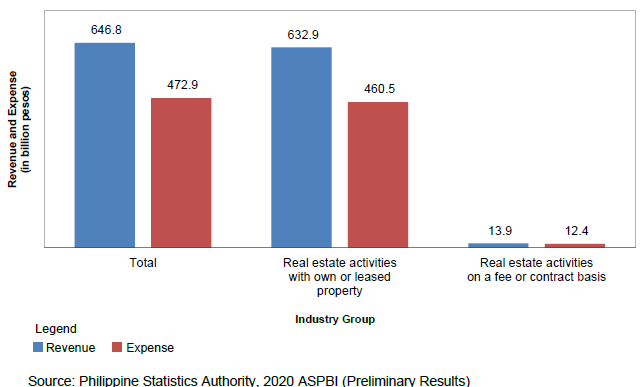
The revenue generated per peso expense by the sector stood at PhP 1.37 in 2020. This means that for every peso spent, a corresponding revenue of PhP 1.37 was generated. By industry group, real estate activities with own or leased property recorded revenue per peso expense ratio of 1.37, while real estate activities on a fee or contract basis generated a ratio of 1.12. (Tables A and 2)
At the regional level, both CALABARZON and Northern Mindanao generated the highest revenue per expense ratio of 1.52, while the lowest revenue per expense ratio was generated in Ilocos Region at 0.86. (Table 4)
Subsidies amounted to PhP 3.12 billion
Subsidies are grants received from the government in the form of financial assistance or tax exemption to aid and develop an industry. Total subsidies received by the sector from the government amounted to PhP 3.12 billion in 2020, a decrease of -79.0 percent from the PhP 14.85 billion reported in 2019. (Table 3)
DENNIS S. MAPA, Ph.D.
Undersecretary
National Statistician and Civil Registrar General
TECHNICAL NOTES
I. Introduction
This Special Release presents the preliminary results of the 2020 Annual Survey of Philippine Business and Industry (ASPBI) for Real Estate Activities establishments (Sector L).
The ASPBI is one of the designated statistical activities of the Philippine Statistics Authority (PSA). Data collected from the survey provide information on the levels, structure, performance, and trends of economic activities of the formal sector in the entire country for the year 2020.
The conduct of the 2020 ASPBI is authorized under Republic Act No. 10625 known as the Philippine Statistical Act of 2013 which mandates reorganizing and strengthening of the Philippine Statistical System (PSS), its agencies and instrumentalities.
II. Data collection and Processing
The survey was conducted nationwide in 2021 with the year 2020 as the reference period, except for employment whose reference period is as of 15 November 2020.
Sample establishments were given various options in accomplishing the survey questionnaire. These were the following:
1. online questionnaire available at https://aspbi.psa.gov.ph;
2. electronic copy of the questionnaire either in portable document format (.pdf) or Excel (.xlsx) file format; and
3. printed copy of the questionnaire.
The Establishment Data Management System (EDMS) was utilized in the decentralized processing of 2020 ASPBI questionnaires in the provinces.
Data are presented by industry group or 3-digit classification as classified under the 2009 Philippine Standard Industrial Classification (PSIC).
III. Taxonomy of Establishments
An establishment is defined as an economic unit under a single ownership or control which engages in one or predominantly one kind of economic activity at a single fixed location.
An establishment is categorized by its economic organization, legal organization, industrial classification, employment size, and geographic location.
Economic Organization refers to the organizational structure or role of the establishment in the organization. An establishment may be single establishment, branch, establishment and main office with branches elsewhere, main office only, or an ancillary unit other than the main office.
Legal Organization refers to the legal form of the economic entity which owns the establishment. An establishment may be a single proprietorship, partnership, government corporation, stock corporation, non-stock corporation, or cooperative.
Industrial classification of an economic unit was determined by the activity from which it derives its major income or revenue. The 2009 PSIC which was approved for adoption by government agencies and instrumentalities through PSA Resolution No. 01 Series of 2017-158 signed on 14 February 2017, was utilized to classify economic units according to their economic activities.
Size of an establishment is determined by its total employment as of the time of visit during the latest Updating of the List of Establishments.
Total Employment (TE) refers to the total number of persons who work in or for the establishment. This includes paid employees, working owners, unpaid workers and all employees who work full-time or part-time including seasonal workers. Also included are persons on short-term leave such as those on sick, vacation or annual leaves, and on strike.
Geographic Classification refers to the grouping of establishments by geographic area using the Philippine Standard Geographic Code (PSGC) classification. The PSGC contains the latest updates on the official number of regions, provinces, cities, municipalities, and barangays in the Philippines. The PSGC as of 31 December 2020 was used for the 2020 ASPBI.
IV. Scope and Coverage
The 2020 ASPBI covered establishments engaged in 18 economic sectors classified under the 2009 PSIC, namely:
1. Agriculture, Forestry and Fishing (A)
2. Mining and Quarrying (B)
3. Manufacturing (C)
4. Electricity, Gas, Steam, and Air Conditioning Supply (D)
5. Water Supply; Sewerage, Waste Management and Remediation Activities (E)
6. Construction (F)
7. Wholesale and Retail Trade; Repair of Motor Vehicles and Motorcycles (G)
8. Transportation and Storage (H)
9. Accommodation and Food Service Activities (I)
10. Information and Communication (J)
11. Financial and Insurance Activities (K)
12. Real Estate Activities (L)
13. Professional, Scientific and Technical Activities (M)
14. Administrative and Support Service Activities (N)
15. Education (P)
16. Human Health and Social Work Activities (Q)
17. Arts, Entertainment and Recreation (R)
18. Other Service Activities (S)
The survey was confined to the formal sector of the economy, which consists of the following:
1. Corporations and partnership
2. Cooperatives and foundations
3. Single proprietorship with employment of 10 and over
4. Single proprietorships with branches
Hence, the 2020 ASPBI covered only the following economic units:
1. All establishments with total employment (TE) of 10 or more; and
2. All establishments with TE of less than 10, except those establishments with Legal Organization = 1 (single proprietorship) and Economic Organization = 1 (single establishment), that are engaged in economic activities classified according to the 2009 Philippine Standard Industrial Classification.
V. Sampling Design
The 2020 ASPBI uses stratified systematic sampling design with 3-digit or 5-digit PSIC as the first stratification variable, depending on the sector, and total employment, which is classified into Micro, Small, Medium establishments (MSME), as the second stratification variable.
Stratified systematic sampling is a process of dividing the population into homogeneous groups, called strata, and then selecting independent samples in each stratum systematically. This method ensures that all important subgroups of the population are represented in the sample and increases precision of “overall” survey estimates.
Domain
The geographic domain of the 2020 ASPBI is region. The industry domain/stratum is 3-digit or 5-digit industry classification, and the employment domain/stratum is the MSME classification.
Unit of Enumeration
The unit of enumeration for the 2020 ASPBI is the establishment.
Sampling Frame of Establishments
The sampling frame for the 2020 ASPBI was extracted from the preliminary 2020 List of Establishments (LE) as of 06 January 2021. This frame was used to draw the sample establishments for the survey. The preliminary 2020 LE showed that there were 1,000,440 establishments in operation in the country of which 336,205 establishments comprised the sampling frame or the establishments that are within the scope and coverage of the 2020 ASPBI.
Estimation Procedure
1) Estimation of Survey Weights
Base Weight
The base weight is the inverse of the probability of selection. For the ASPBI, the base weight for each domain is given by:

where:
whk = weight of the kth establishment in the hth stratum
Nh = total no. of establishments in the hth stratum
nh = total no. of sample establishments in the hth stratum
h = refers to the industry-employment stratum
Adjustment Factor
To take into account the non-responding sample establishments, the adjustment factor by region and industry domain is as follows:

where:
As = adjustment factor for industry domain s
X1k = eligibility status of the kth sample establishment (1 if eligible, 0 otherwise)
X2k = responding status of the kth sample establishment (1 if responding, 0 otherwise)
Final Weight
The final weight is the product of the base weight and adjustment factor. That is,

where:
w'hk = final weight of the kth sample establishment in stratum h
whk = weight of the kth establishment in the hth stratum
As = adjustment factor for industry domain s
2) Estimation of Total
Total by Industry-Employment Stratum
The estimator for the total of a characteristic in each industry-employment stratum in a region (geographic domain) is given by:

where:
yhk = value of the kth sample establishment in stratum h
w’hk = final weight of the kth sample establishment in stratum h
Total by Industry Stratum and Domain
The estimator for the total of a characteristic in each industry stratum in each regional domain is given by:
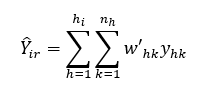
where:
hi = number of employment strata for industry stratum i
Total by Employment Stratum and Domain
The estimator for the total of a characteristic in each employment stratum in each regional domain is given by:

where:
hj = number of industry strata for employment stratum j
r = subscript for geographic domain r
Total by Geographic Domain
The estimator for the total of a characteristic in each geographic domain is given by:
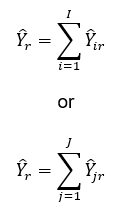
where:
I = total number of industry strata in geographic domain r
J = total number of employment strata in geographic domain r
Total by Industry Stratum (National)
The estimator for the national total of a characteristic in each industry domain/stratum is given by:

where:
R = total number of regions
Total by Employment Stratum (National)
The estimator for the national total of a characteristic in each employment domain/stratum is given by:

National Total
The estimator for the national total of a characteristic is given by:

VI. Response Rate
Response rate for all Real Estate Activities sector was 78.7 percent (318 out of 404 establishments). This included receipts of "good" questionnaires, partially accomplished questionnaires, and reports of closed, moved out or out-of-scope establishments.
Of the total responses, 13 establishments responded online
Reports of establishments which were found to be duplicate of another establishment, out-of-scope and out of business in 2020 were not included in the generation of statistical tables.
VII. Concepts and Definitions of Terms
Compensation is the sum of salaries and wages, separation/retirement/terminal pay, gratuities, and payments made by the employer on behalf of the employees such as contribution to SSS/GSIS, ECC, PhilHealth, Pag-ibig, etc.
Establishment is an economic unit under a single ownership and control, i. e. under a single entity, engaged in one or predominantly one kind of economic activity at a single fixed location.
Expense is the cost incurred by the establishment during the year whether paid or payable. This is treated on a consumed basis. Valuation is at purchaser price including taxes and other charges, net of rebates, returns, and allowances. Goods and services received by the establishment from other establishments of the same enterprise are valued as though purchased.
Paid employees are all persons working in the establishment and receiving pay, as well as those working away from the establishment paid by and under the control of the establishment. Included are all employees on sick leave, paid vacation, or holiday. Excluded are consultants, home workers, receiving pure commissions only, and workers on indefinite leave.
Revenue is the cash received and receivables for goods/products and by-products sold and services rendered. Valuation is at producer prices (ex-establishment) net of discounts and allowances, including duties and taxes but excluding subsidies.
Salaries and wages are payments in cash or in kind to all employees, prior to deductions for employee’s contributions to SSS/GSIS, withholding tax, etc. Included are total basic pay, overtime pay, and other benefits.
Subsidies are special grants in the form of financial assistance or tax exemption or tax privilege given by the government to aid and develop an industry.
